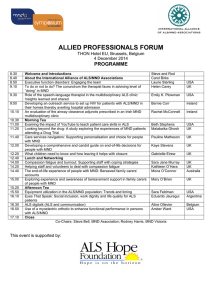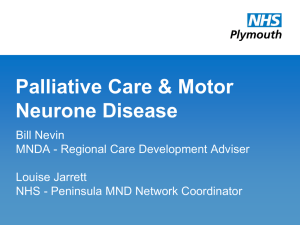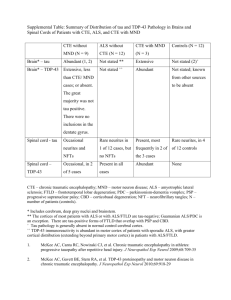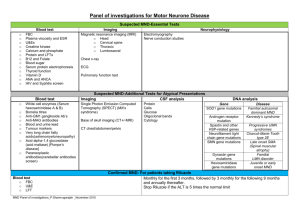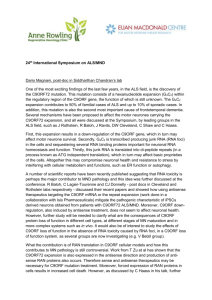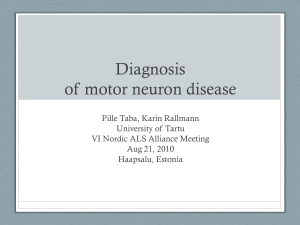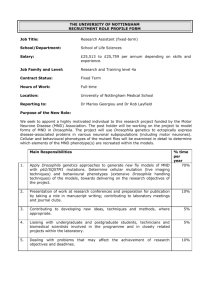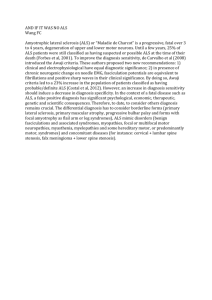Motor Neuron Disease
advertisement
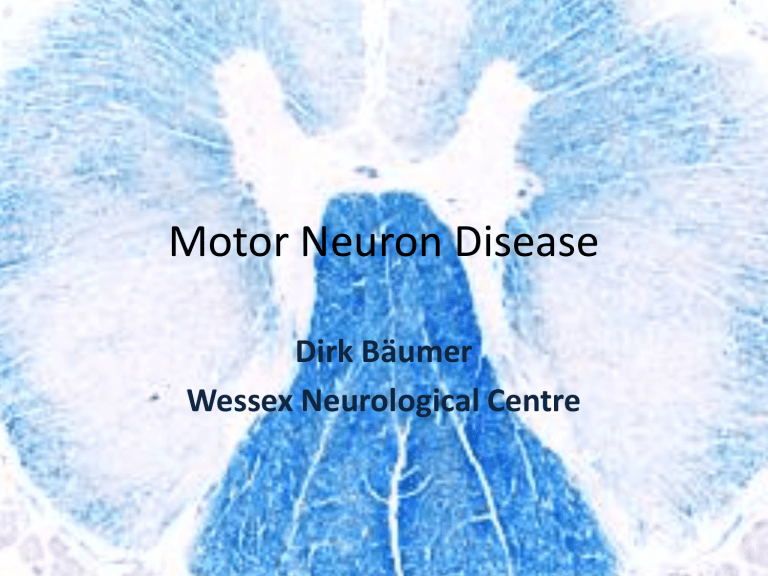
Motor Neuron Disease Dirk Bäumer Wessex Neurological Centre MND – take home points There is no diagnostic test for MND – but clinical diagnosis is reliable Mean survival is 3-4 years, but there are marked differences between patients Multidisciplinary care makes a difference What is Motor Neuron Disease? What is MND? What is ALS? Some terminology Clinical features Pathology What is causing it? Environment vs genetics Overview of management What is Motor Neuron Disease? “upper motor neuron” corticospinal tract NEJM 2001 344 (22): 1688 “lower motor neuron” anterior horn cell What is ALS (Amyotrophic lateral sclerosis) Amyotrophy Lateral sclerosis muscle loss from denervation degeneration of the lateral corticospinal tract (upper motor neuron) ALS = MND What is ALS? Charcot’s disease Jean-Martin Charcot 1874 La sclérose latérale amyotrophique “lateral sclerosis” What is ALS? Lou Gehrig’s disease 0.6 Batting average 0.5 0.4 0.3 0.2 0.1 0 1922 1924 1926 1928 1930 1932 Year 1934 1936 1938 1940 What is ALS? Lou Gehrig’s disease http://www.lougehrig.com/about/bio.html MND: Clinical features and diagnosis • Essential: Progressive pure motor weakness • Combination of lower motor neuron and upper motor neuron dysfunction: – LMN: weakness, wasting and fasciculations – UMN: Stiffness (spasticity), brisk reflexes, extensor plantar responses • Almost always: Focal onset – Upper limb 30% – Lower limb 35% – Bulbar 30% – Respiratory 1-2% – Trunk 1-2% • All this not explained by another condition MND: Clinical features and diagnosis Kiernan et al Lancet 2011 MND: ‘Diagnostic criteria’ and tests Sensitivity as low as 28%! NOT used in clinical practice Clinical features features and diagnosis MND: Clinical – About 25% of cases – ‘progressive bulbar palsy’ – Presents with dysarthria and dysphagia – Often seen in TIA clinic because of perceived ‘stroke-like’ onset – Typically combination of upper motor neuron (corticobulbar, or ‘pseudobulbar’) and lower motor neuron bulbar problems – More common in elderly females – Generally worse prognosis – but there are long survivors Bulbar onset ALS Clinical features features and diagnosis MND: Clinical ‘Flail arm’ syndrome • Vulpian-Bernhardt syndrome, brachial amyotrophic diplegia or ‘Man-in-the-barrel’ • Usually severe symmetrical shoulder girdle wasting Regional variants ‘Flail leg’ syndrome • ‘Polyneuritic variant’ or MariePatrikios syndrome • Asymmetric distal leg wasting • Very few pathological cases Wijesekera et al 2009 MND: Clinical features and diagnosis Clinical features Primary lateral sclerosis (PLS) • Rare (2% of all cases) • Pure upper motor neuron disease – Stiffness and spasticity – Progressive ascending tetraparesis – Spastic dysarthria • No wasting or fasciculation • Weakness may take some time to develop • Survival is prolonged (decades) • By convention only diagnosed after 5 years of symptoms • Can look like PSP Clinical features features and diagnosis Dementia in MND MND: Clinical • Frontal or ‘dysexecutive’ syndrome – Apathy, disinhibition or stereotypies – Socially inappropriate behaviour – Language (rare) • • • • Memory, orientation and visuospatial skills preserved Emotionality is not always associated with dementia Can develop before or after motor weakness Dementia up to 15%, cognitive impairment up to 50% Clinical features features and diagnosis Dementia in MND MND: Clinical MND: Differential diagnosis diagnosis of MND Differential In theory… In practice… 7.3% ‘mimic syndromes’ in 405 clinical diagnoses Traynor et al Arch Neurol 2000 Differential diagnosis – cervical spondylotic radiculomyelopathy What causes MND? Pathology Olaf Ansorge What causes MND? Epidemiology 700 Alzheimer’s Disease 1.3/1000 7000 6000 5000 4000 3000 2000 1000 0 60 70 80 90 100 Age 400 300 200 0 40 50 60 70 80 90 Age Motor Neuron Disease 3/100 000 (lifetime risk 1:300-1:400) 12 Rate per 100,000 500 100 50 14 Parkinson’s Disease 1.6/10 000 600 Incidence per 100,000 Rate per 100,000 10000 9000 8000 10 8 6 Incidence of neurodegenerative disorders 4 2 0 10 20 30 40 50 Age 60 70 80 90 Hirtz et al, NEUROLOGY 2007;68:326-337 What causes MND? Epidemiology What causes MND? Genetics 5-10% of patients have a family history Familial disease is indistinguishable from sporadic disease What is familial ALS? Experts disagree… What causes MND? Genetics Genetic disease may appear sporadic in small families and with low penetrance ‘Familial inheritance’ can be seen as a proxy measure of penetrance Al-Chalabi et al 2011 What causes MND? Genetics 8 fold increase of risk of siblings to develop MND by the age of 85 Absolute risk still very small What causes MND? Genetics C9orf72: • >30% of ‘familial’ ALS cases, >5% of sporadic ALS cases, • >25% of familial FTD cases,>5 % of sporadic FTD cases How does C9orf72 cause MND? Loss of C9orf72 function RNA gain of function Toxic RAN translation Differential expression Somatic mosaicism Differential methylation Preferential vulnerability Does MND spread? Ravits and La Spada 2009 When does MND start? Eisen et al 2014 MND classification and overview Lateral Sclerosis (ALS/MND) Motor Neuron Disease/Amyotrophic LMN/UMN P h e n o t y p e Motor/cognitive PLS Spinal/limb ALS UMN predominant ALS ALS-FTLD ‘typical’ ALS FTLD-MND LMN predominant ALS Neuropathology SOD1 Bulbar TDP-43 Respiratory TDP-43/DPR Flail arm FTLD FUS Flail leg PMA G e n o t y p e Region of onset ‘Sporadic ALS’ ‘Familial ALS’ High penetrance mutations rare variants C9orf72 SOD1 TARDBP FUS UBQLN2 OPT ANG TAF15 EWRS1 ‘at risk genotypes’ UNC13A ELP3 ATXN2 complex models Liability threshold model MND management - Conveying the diagnosis Diagnosis • • • • • Are you sure of the diagnosis? Do you have the knowledge? Do you have the support structures? The role of a specialist clinic 20-30% of people initially diagnosed with MND by non-neurologists do not have it • The experience of how the diagnosis is given has a long term impact MND - prognosis Turner and Talbot 2013 MND - prognosis Range 6 months – 20 years Millul et al Neuroepidemiology 2005 MND management - talking about prognosis Prognosis Motor Neurone Disease Survival from symptom onset 100% Range 6 months – 20 years Mean 3-4 years 50% 5 years Slide: Kevin Talbot 10 years 15 years MND - prognosis Better prognosis • The rate of change in the first year • Pure UMN or pure LMN syndromes • Regional syndromes (upper or lower limb) Worse prognosis • Early diagnosis • Elderly • Bulbar onset • Early respiratory involvement • Neck weakness Nakamura et al 2013 MND – management Riluzole Mean survival 14.8 months on Riluzole, 11.8 months off treatment Well tolerated but need to monitor LFTs every month for three months, then every three-monthly for 9 months Miller et al Cochrane Review 2008 MND management – the multidisciplinary team MND management – the multidisciplinary team JNNP 2015 Thank you! dirk.baumer@uhs.nhs.uk
